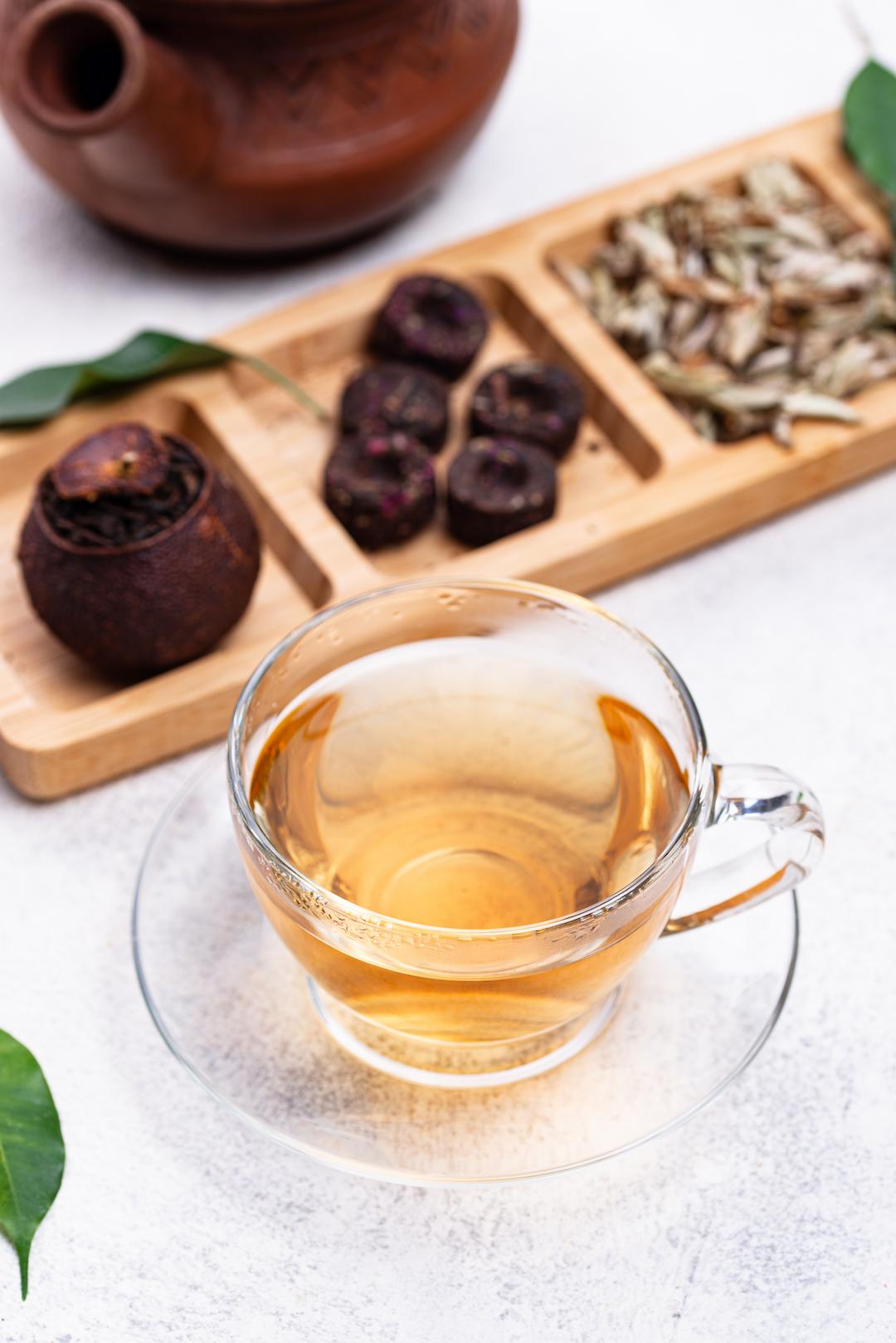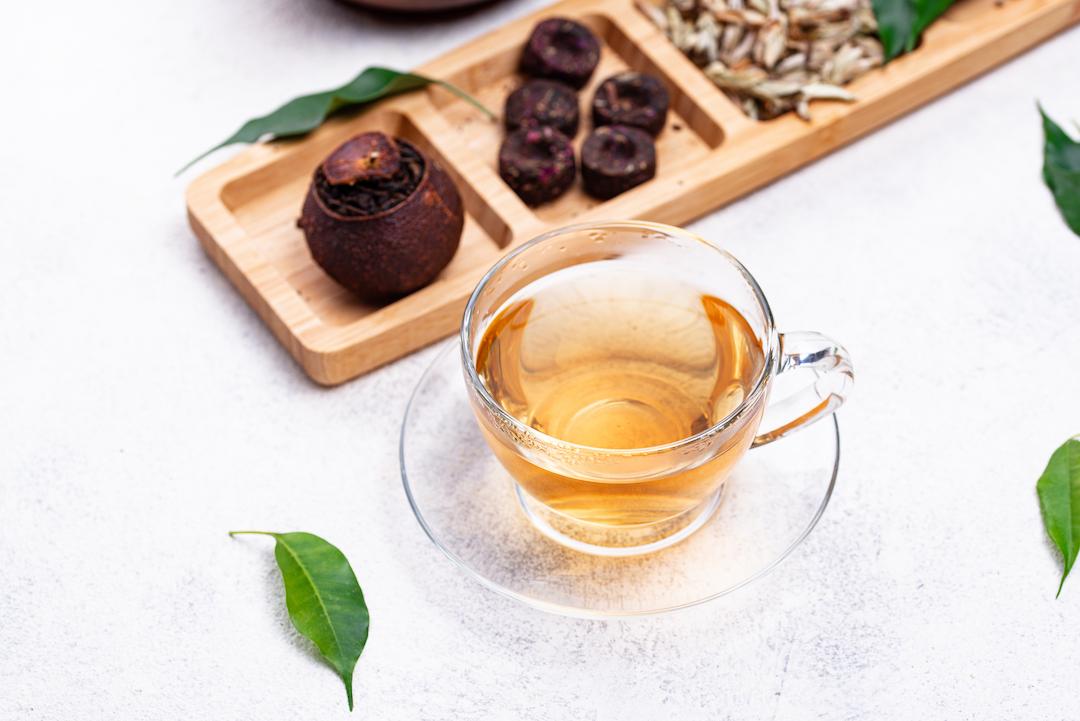White Tea: Types & Brewing Tips for A Delicate Tea
Posted by Elise Goldsworthy BHSc (Nutrition Science) on 12th Apr 2022
White tea may be a lesser known tea compared to green or black tea. Yet, the subtle flavour and fragrance of white tea is worth discovering for yourself. Long revered as a symbol of nobility and purity, white tea has an airy delicate flavour and has been enjoyed as a traditional Chinese tea for centuries. White tea is also known as ‘silver tips’ tea. It is the least processed of all teas from the camellia sinensis plant.
White tea is considered a ‘true tea’, together with green, oolong, black and pu-erh teas. White tea is made using the newly sprouted buds from the tea plant. It is minimally processed, and some white tea varieties use young leaves that have been steamed or air dried. White tea does not undergo rolling or oxidisation. This helps retain the light and fragrant flavour for which it is famed. There are many types of white tea and each gives a unique and different flavour.
White tea is a slightly sweet brew that is great for most palates. White tea is enjoyable especially if you’re not a fan of the astringency of green tea or pungency of black tea. White tea challenges the taste buds to detect the gentle and delicate notes that tea can truly offer. Discover all there is to know about white tea, its types and brewing tips for a delicate tea every time.
History of White Tea
White tea is a traditional Chinese tea, with some evidence to suggest its origins date back to between 600 - 1300 A.D. Primarily, white tea has been harvested in the Fujian province of China. White tea was commonly offered to royal Chinese emperors as a sign of gratitude and respect from local villagers.
This silvery-tipped tea was almost exclusively enjoyed by Chinese nobility and anyone in their close company. White tea was often enjoyed as a powder or added to cakes. Later, during the Song Dynasty, it was customary to add chrysanthemum flowers to enhance the delicate flavours of white tea preparations. The Qing Dynasty began to use fresh loose leaves of white tea for brewing instead of using the powdered form. White tea can now be produced in Nepal, Taiwan, Thailand, and India.

How Is White Tea Produced?
The method for producing white tea is a lot simpler than other true teas. Because white tea is made using immature leaves and new buds from the tea plant, very little processing occurs. This preserves the lovely flavour for which white tea is renowned. The tea leaves are harvested only during the first few days of the initial tea flush each year. This is what makes them so special and revered for true tea fans.
The basic process for making white tea comprises three steps. White tea is simply harvested, withered and dried. Each silvery leaf is hand-picked and withered for 3 days, either in the sun or in a climate-controlled environment. The finished product for white tea is achieved when the moisture content of the leaves is around one percent. This uncomplicated and fast production method makes white tea among some of the freshest teas available.
Flavour & Aroma
White tea has a smooth and soft, ‘barely there’ flavour. It can come as a surprise to tea-drinkers who usually enjoy a strong and robust cup of tea. White tea imparts a lovely sweetness, and has a pared back mild flavour profile that suits most palettes.
Flavours detectable in white tea include honey, vanilla, melon and peach. This tea has a light to medium-bodied flavour with a lot of nuanced interest in the flavour profile. Brewed white tea is a pale ivory colour, which reflects its delicate tasting notes. A regular cup of white tea has about one-third of the caffeine found in a cup of coffee.
Health Benefits of White Tea
There’s a plethora of studies that demonstrate the perks of tea drinking. Tea that’s derived from the camellia sinensis tea plant has antioxidant, anti-inflammatory, cardioprotective, anti-obesity and liver protecting properties. These health benefits apply to black, green and white teas alike. It’s wonderful if you want to try something different and still reap the benefits of a classic cup of tea. Here’s just a few of the many health benefits of drinking white tea.
Promotes relaxation
A key component of tea is the plant compound known as L-theanine. Research has shown that consumption of foods containing L-theanine induces alpha brain wave activity. This is experienced as an alert and wakeful feeling, while also being relaxed. Drinking white tea is a fantastic way to promote a relaxed state and support concentration, especially during stressful situations.
Supports heart health
The polyphenolic compounds in white tea are uniquely effective in improving glucose and cholesterol metabolism. White tea enhances LDL cholesterol binding activity, and increases HDL cholesterol concentration. This means white tea is cardioprotective and can support heart and blood vessel health.
Helps with weight loss
White tea helps to decrease lipid (fat) absorption and increase the body’s ability to burn fat cells, which stimulate energy production. Epidemiological studies support this finding, with reductions observed in weight, BMI and visceral body fat. Coupled with white tea’s cardioprotective activities, these results mean white tea is a healthy option to support metabolic health.
White Tea Varieties
It may come as a surprise to learn that white tea isn’t just white tea. In fact, there’s several varieties, all with differing characteristics and places of origin. Read on to learn about white tea varieties and their intriguing origins.
Silver Needle White Tea (Baihao Yinzhen)
Silver needle is a white tea variety that is considered the highest quality, top shelf white tea available. It’s popular among tea enthusiasts and contains only buds from the tea plant. Hailing from the Fujian tea province, harvesting involves collecting the newest buds from the Da Bai tea plant. This ‘first flush’ occurs around mid-March and lasts only a few weeks during warm weather.
The term ‘silver needle’ is due to the dainty white hairs visible along the green tea leaves. The tea leaves feel soft to the touch. While steeping, silver needle white tea buds dazzle their beholder, with a glistening silver hue as each leaf reflects the light.
Silver needle white tea benefits from a brewing temperature of just over 70 degrees celsius. This is because of the innate delicacy of white tea, it can’t withstand hotter boiling temperatures that black tea will tolerate. Steeping time is around 5 minutes and the result is a pale yellow infusion that is airy, sweet and fragrant.
White Peony White Tea (Bai MuDan)
Just beneath silver needle tea in terms of quality, is white peony white tea. It’s considered the second-highest ranking white tea amongst tea experts. Where silver needle tea uses only the immature camellia sinensis buds, white peony white tea uses a mixture of two opened tea leaves and one unopened bud to create a unique tea experience.
A classic white peony tea infusion will yield a pale green or subtle champagne colour in the final brew. It’s slightly stronger than silver needle tea and has floral top notes that make it refreshing and enjoyable.
Long Life White Tea (Shoumei Tea)
Shoumei tea is a traditional Chinese white tea reminiscent of oolong green tea. Cultivated in the Fujian or Guangxi provinces in China, shoumei tea still classifies as a white tea, while gaining strength in flavour and aroma. The top few leaves are hand-picked to make this tea, which contribute to the increasingly darker colour once brewed. Shoumei tea has an earthier flavour and offers significantly more boldness as a wonderful white tea variety.
Darjeeling White Tea
As the name suggests, this white tea is produced in the high-altitude regions of India instead of China. Tea leaves are dried in sunlight and when brewed, the tea is a rich gold colour. Darjeeling white tea provides a sweeter, more mellow flavour profile than the classic white tea types.
Ceylon White Tea
Produced in Sri Lanka, another wonderful white tea worth trying is a Ceylon variety. This white tea can be difficult to source, as it’s only made using the longest silver tea buds. The result is a fruity and fragrant tea with notes of honey, and a mild astringency that’s quite enjoyable.
Imperial Himalayan White Tea
This variety of white tea is unique, in that it is produced during the autumn harvest instead of summer as per traditional white teas. Originating from the Himalayan mountains, this tea is uniquely grown and harvested in very high altitude tea estates and therefore has a strong, robust flavour with fruity and floral undertones.
Tips For Brewing White Tea
As a rule, loose leaf tea produces the most authentic flavour and aroma, and also provides the maximal amount of health benefits. Pure filtered or spring water is always best to brew your tea. Importantly, because white tea is vulnerable to high temperatures, it’s best not to use boiling water when brewing your tea.

How To Brew A Perfectly Delicate White Tea
Ingredients
- 250ml filtered water
- 2 tsp. White tea (more can be added for leaf versus bud tea)
- 1 tsp. Honey (optional)
Instructions
- In a pot, bring water to a boil then remove from heat. Wait until water is between 70-90 degrees C.
- After a minute, add 2 teaspoons of white tea buds or leaves
- Steep the tea for up to 10 minutes for the strongest flavour
- Add honey if desired and enjoy
References
FX Medicine, Education, L-theanine - learning and cognition, https://www.fxmedicine.com.au/content/l-theanine-learning-and-cognition, viewed April 6, 2022
FX Medicine, Education, L-theanine - calming neutraliser, https://www.fxmedicine.com.au/blog-post/l-theanine-calming-neutraliser, viewed April 6, 2022
Hinojosa-Nogueira, D., Pérez-Burillo, S., Pastoriza de la Cueva, S., & Rufián-Henares, J. Á. (2021). Green and white teas as health-promoting foods. Food & function, 12(9), 3799–3819. https://doi.org/10.1039/d1fo00261a
https://citeseerx.ist.psu.edu/viewdoc/download?doi=10.1.1.696.8743&rep=rep1&type=pdf
López, V., & Calvo, M. I. (2011). White tea (Camellia sinensis Kuntze) exerts neuroprotection against hydrogen peroxide-induced toxicity in PC12 cells. Plant foods for human nutrition (Dordrecht, Netherlands), 66(1), 22–26. https://doi.org/10.1007/s11130-010-0203-3
Tang, G. Y., Meng, X., Gan, R. Y., Zhao, C. N., Liu, Q., Feng, Y. B., Li, S., Wei, X. L., Atanasov, A. G., Corke, H., & Li, H. B. (2019). Health Functions and Related Molecular Mechanisms of Tea Components: An Update Review. International journal of molecular sciences, 20(24), 6196. https://doi.org/10.3390/ijms20246196
Tenore, G. C., Stiuso, P., Campiglia, P., & Novellino, E. (2013). In vitro hypoglycaemic and hypolipidemic potential of white tea polyphenols. Food chemistry, 141(3), 2379–2384. https://doi.org/10.1016/j.foodchem.2013.04.128
Wikipedia Contributors. (2022, April 6). Baihao Yinzhen. Retrieved from Wikipedia website: https://en.wikipedia.org/wiki/Baihao_Yinzhen, viewed April 6, 2022
Wikipedia Contributors. (2022, April 6). Bai Mudan. Retrieved from Wikipedia website: https://en.wikipedia.org/wiki/Bai_Mudan, viewed April 6, 2022
Wikipedia Contributors. (2022, April 6). Shoumei tea. Retrieved from Wikipedia website: https://en.wikipedia.org/wiki/Shoumei_tea, viewed April 6, 2022
Wikipedia Contributors. (2022, April 6). White tea. Retrieved from Wikipedia website: https://en.wikipedia.org/wiki/White_tea, viewed April 6, 2022
- Lee , D. Lee , E. Han and J. Choi , Intake of green tea products and obesity in nondiabetic overweight and obese females: A systematic review and meta-analysis, J. Funct. Foods, 2019, 58 , 330 —337
